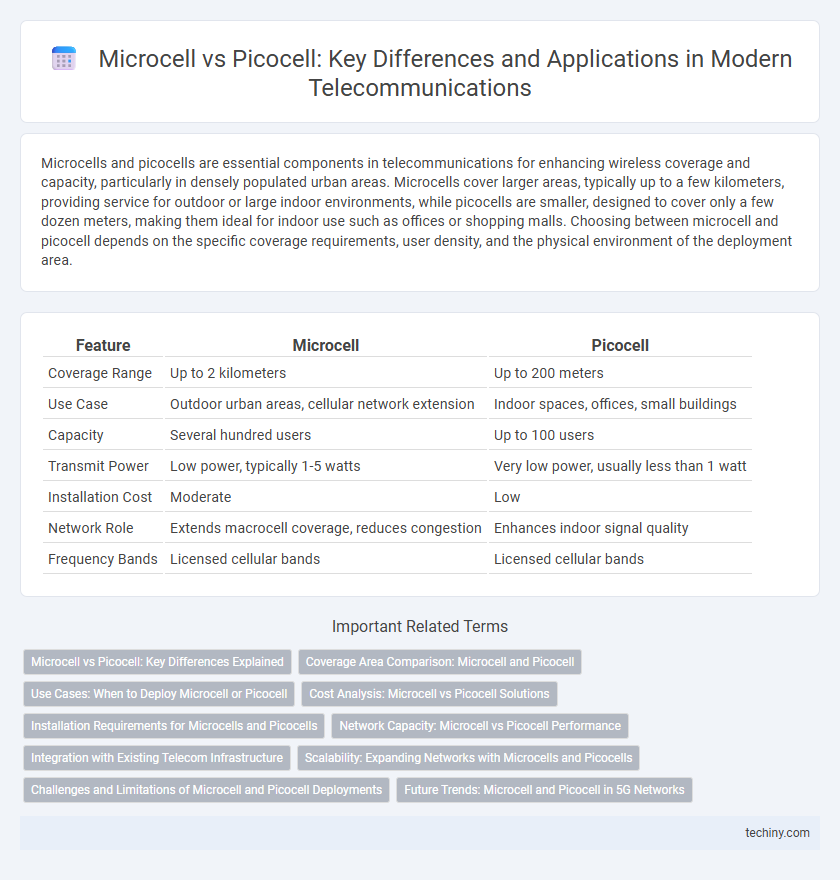Microcells and picocells are essential components in telecommunications for enhancing wireless coverage and capacity, particularly in densely populated urban areas. Microcells cover larger areas, typically up to a few kilometers, providing service for outdoor or large indoor environments, while picocells are smaller, designed to cover only a few dozen meters, making them ideal for indoor use such as offices or shopping malls. Choosing between microcell and picocell depends on the specific coverage requirements, user density, and the physical environment of the deployment area.
Table of Comparison
| Feature | Microcell | Picocell |
|---|---|---|
| Coverage Range | Up to 2 kilometers | Up to 200 meters |
| Use Case | Outdoor urban areas, cellular network extension | Indoor spaces, offices, small buildings |
| Capacity | Several hundred users | Up to 100 users |
| Transmit Power | Low power, typically 1-5 watts | Very low power, usually less than 1 watt |
| Installation Cost | Moderate | Low |
| Network Role | Extends macrocell coverage, reduces congestion | Enhances indoor signal quality |
| Frequency Bands | Licensed cellular bands | Licensed cellular bands |
Microcell vs Picocell: Key Differences Explained
Microcells provide wireless coverage over larger areas, typically ranging from 200 meters to 2 kilometers, while picocells cover much smaller zones, generally under 200 meters. Both enhance network capacity and indoor coverage, but microcells support higher user densities and connect to macrocell networks for seamless handovers. Picocells are ideal for confined spaces like office floors, whereas microcells serve suburban or densely populated urban sectors requiring extended coverage.
Coverage Area Comparison: Microcell and Picocell
Microcells typically cover a larger area ranging from 200 meters to 2 kilometers, ideal for enhancing capacity in urban regions or along busy streets. Picocells provide a smaller coverage radius, generally up to 200 meters, optimizing indoor environments like offices, shopping malls, and train stations. The distinct coverage scales of microcell and picocell enable tailored network deployments to improve signal strength and manage user density effectively.
Use Cases: When to Deploy Microcell or Picocell
Microcells are ideal for enhancing coverage in moderately dense urban areas or along busy roads where additional capacity is needed without widespread interference. Picocells suit indoor environments such as office buildings, shopping malls, and airports, providing focused coverage and improved signal strength in compact spaces. Deploying microcells addresses broader outdoor network gaps, while picocells optimize performance in localized indoor settings.
Cost Analysis: Microcell vs Picocell Solutions
Microcells generally offer a balanced cost structure with moderate installation and maintenance expenses suitable for expanding coverage in suburban or small urban areas. Picocells feature lower deployment costs and reduced power consumption, making them ideal for dense indoor environments and hotspots requiring focused capacity. Evaluating the total cost of ownership highlights microcells as cost-effective for broader coverage, while picocells minimize expenses in localized, high-traffic zones.
Installation Requirements for Microcells and Picocells
Microcells typically require outdoor installation on streetlights, utility poles, or building exteriors, necessitating robust weatherproof enclosures and access to power and backhaul connectivity. Picocells are installed indoors, often in offices, shopping centers, or residential buildings, with simpler mounting options such as walls or ceilings and standard Ethernet or cellular backhaul connections. Both microcells and picocells demand precise site surveys to optimize signal coverage and minimize interference in urban or densely populated environments.
Network Capacity: Microcell vs Picocell Performance
Microcells typically cover areas up to 2 kilometers with moderate capacity, making them ideal for boosting network performance in urban hotspots. Picocells operate within a range of 200 meters and provide higher capacity per unit area due to their dense deployment, effectively managing heavy traffic in confined spaces such as malls or office buildings. The enhanced network capacity of picocells reduces congestion and improves overall data rates, while microcells balance broader coverage with substantial capacity enhancements.
Integration with Existing Telecom Infrastructure
Microcells integrate seamlessly with existing telecom infrastructure by enhancing coverage and capacity within urban or densely populated areas without requiring major overhauls of current network systems. Picocells, designed for indoor environments such as offices or shopping malls, provide targeted signal improvement by connecting directly to the enterprise's broadband network, ensuring efficient use of existing backhaul resources. Both microcells and picocells support network scalability and reduce macrocell load, optimizing the overall performance of 4G and 5G deployments.
Scalability: Expanding Networks with Microcells and Picocells
Microcells and picocells offer distinct scalability advantages for expanding telecommunications networks, with microcells covering larger areas and supporting higher user capacities compared to picocells. Microcells efficiently enhance network reach in urban and suburban environments, providing scalability through broader coverage and increased traffic handling. Picocells deliver targeted capacity improvements in high-density indoor locations, enabling scalable densification of networks without extensive infrastructure deployment.
Challenges and Limitations of Microcell and Picocell Deployments
Microcell deployments face challenges such as limited coverage range and increased interference in dense urban environments, which complicate handoff management and spectrum allocation. Picocells, while offering enhanced capacity in small areas, encounter limitations including higher infrastructure costs and complex backhaul requirements that impact scalability. Both microcells and picocells must address signal penetration issues and network integration complexities to optimize performance in heterogeneous cellular networks.
Future Trends: Microcell and Picocell in 5G Networks
Microcells and picocells play a crucial role in 5G network densification, enabling enhanced coverage and higher data throughput in urban and indoor environments. The integration of these small cells supports massive MIMO technology and beamforming, essential for meeting 5G's low latency and high capacity requirements. Future deployments focus on dynamic spectrum allocation and AI-driven network management to optimize microcell and picocell performance in increasingly complex 5G ecosystems.
Microcell vs Picocell Infographic

 techiny.com
techiny.com